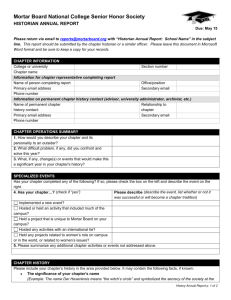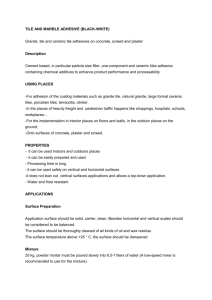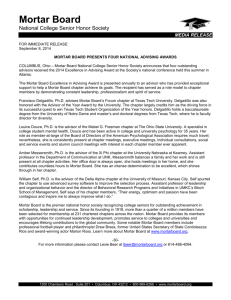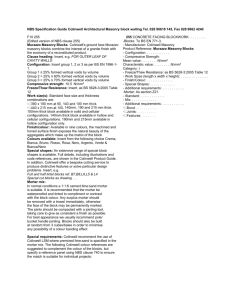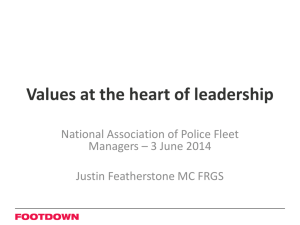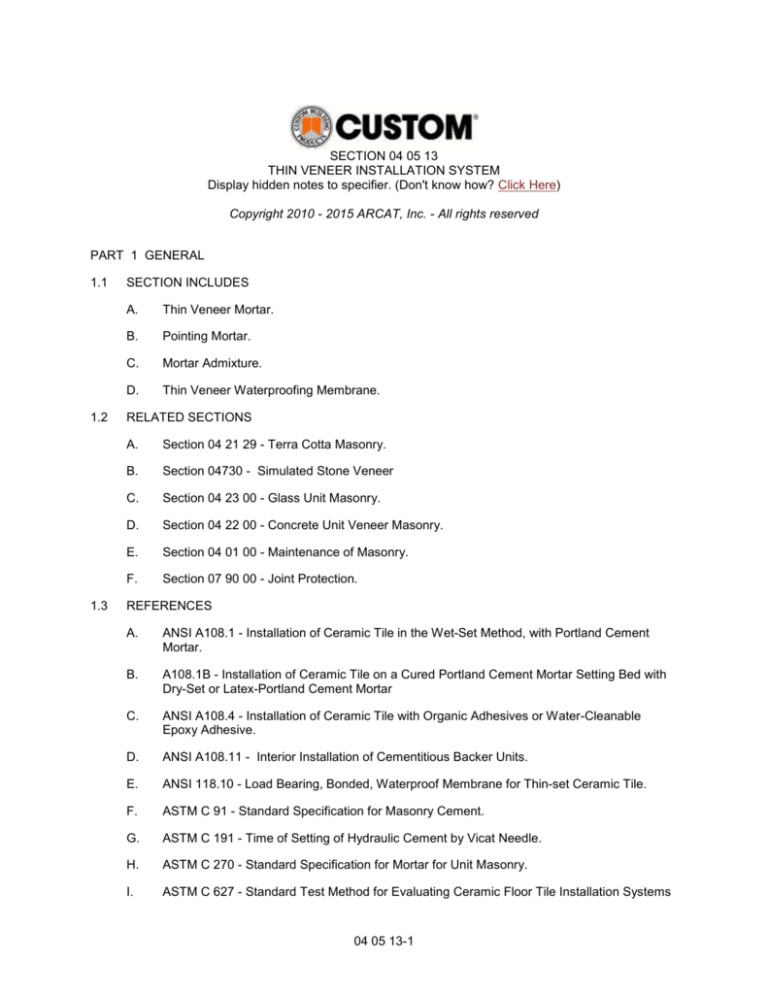
SECTION 04 05 13
THIN VENEER INSTALLATION SYSTEM
Display hidden notes to specifier. (Don't know how? Click Here)
Copyright 2010 - 2015 ARCAT, Inc. - All rights reserved
PART 1 GENERAL
1.1
1.2
1.3
SECTION INCLUDES
A.
Thin Veneer Mortar.
B.
Pointing Mortar.
C.
Mortar Admixture.
D.
Thin Veneer Waterproofing Membrane.
RELATED SECTIONS
A.
Section 04 21 29 - Terra Cotta Masonry.
B.
Section 04730 - Simulated Stone Veneer
C.
Section 04 23 00 - Glass Unit Masonry.
D.
Section 04 22 00 - Concrete Unit Veneer Masonry.
E.
Section 04 01 00 - Maintenance of Masonry.
F.
Section 07 90 00 - Joint Protection.
REFERENCES
A.
ANSI A108.1 - Installation of Ceramic Tile in the Wet-Set Method, with Portland Cement
Mortar.
B.
A108.1B - Installation of Ceramic Tile on a Cured Portland Cement Mortar Setting Bed with
Dry-Set or Latex-Portland Cement Mortar
C.
ANSI A108.4 - Installation of Ceramic Tile with Organic Adhesives or Water-Cleanable
Epoxy Adhesive.
D.
ANSI A108.11 - Interior Installation of Cementitious Backer Units.
E.
ANSI 118.10 - Load Bearing, Bonded, Waterproof Membrane for Thin-set Ceramic Tile.
F.
ASTM C 91 - Standard Specification for Masonry Cement.
G.
ASTM C 191 - Time of Setting of Hydraulic Cement by Vicat Needle.
H.
ASTM C 270 - Standard Specification for Mortar for Unit Masonry.
I.
ASTM C 627 - Standard Test Method for Evaluating Ceramic Floor Tile Installation Systems
04 05 13-1
Using the Robinson-Type Floor Tester.
1.4
1.5
SUBMITTALS
A.
Submit under provisions of Section 01 30 00.
B.
Product Data: Manufacturer's data sheets on each product to be used, including:
1.
Preparation instructions and recommendations.
2.
Storage and handling requirements and recommendations.
3.
Installation methods.
C.
LEED Submittals: Provide documentation of how the requirements of Credit will be met:
1.
Product Data for Credit MR 2.1 and 2.2: For products being recycled, documentation
of total weight of project waste diverted from landfill.
2.
Product Data for Credit MR 4.1 and MR 4.2: For products having recycled content,
documentation including percentages by weight of post consumer and preconsumer
recycled content
a.
Include statement indicating costs for each product having recycled content.
3.
Product Data for Credit EQ 4.1: For adhesives, including printed statement of VOC
content
4.
Product Data for Credit IAQ 4.6 (Schools): For products used in school construction,
including certification meeting CHPS Low-Emitting Material criteria Section 01350
5.
Product Data for Credit MR 5.1 and Credit MR 5.2: Submit data, including location
and distance from Project of material manufacturer and point of extraction, harvest or
recovery for main raw material.
a.
Include statement indicating cost for each regional material and the fraction by
weight that is considered regional.
D.
Selection Samples: For each finish product specified, two complete sets of color chips
representing manufacturer's full range of available colors and patterns.
E.
Verification Samples: For each finish product specified, two samples, minimum size 6
inches (150 mm) square, representing actual product, color, and patterns.
F.
Manufacturer's Certificates: Certify products meet or exceed specified requirements.
QUALITY ASSURANCE
A.
Manufacturer Qualifications: Company specializing in manufacturing the products of this
section with minimum ten years documented experience.
B.
Installer Qualifications: Company specializing in performing the work of this section with
minimum five years documented experience.
C.
Mock-Up: Provide a mock-up for evaluation of surface preparation techniques and
application workmanship.
1.
Locate mock-ups on site in locations and size directed by Architect.
2.
Finish areas designated by Architect.
3.
Do not proceed with remaining work until workmanship and color is approved by
Architect.
4.
Refinish mock-up area as required to produce acceptable work.
5.
Retain and maintain mock-ups during construction in undisturbed condition as a
standard for judging completed unit of Work.
6.
Obtain Architect's acceptance of mock-ups before start of final unit of Work.
D.
Conduct conference at Project site to comply with requirements of Division 1 Section
"Project Meetings."
04 05 13-2
1.6
1.7
1.8
1.9
DELIVERY, STORAGE, AND HANDLING
A.
Deliver and store packaged materials in original containers with seals unbroken and labels
intact until time of use.
B.
Prevent damage or contamination to materials by water, freezing, foreign matter and other
causes.
C.
Store and dispose of solvent-based materials, and materials used with solvent-based
materials, in accordance with requirements of local authorities having jurisdiction.
SEQUENCING
A.
Ensure that locating templates and other information required for installation of products of
this section are furnished to affected trades in time to prevent interruption of construction
progress.
B.
Ensure that products of this section are supplied to affected trades in time to prevent
interruption of construction progress.
PROJECT CONDITIONS
A.
Maintain environmental conditions (temperature, humidity, and ventilation) within limits
recommended by manufacturer for optimum results. Do not install products under
environmental conditions outside manufacturer's absolute limits.
B.
Environmental: Install mortar, set and point mortar when surfaces and ambient temperature
is minimum 50 degrees F (10 degrees C) and maximum 90 degrees F (32 degrees C).
Consult with manufacturer for specific requirements.
C.
Do not install mortar, set or point masonry on exterior when inclement weather conditions
are expected within 48 hours after work is completed unless properly protected.
D.
Protection: Protect adjacent work surfaces during tile work. Close rooms or spaces to traffic
of all types until mortar has set.
E.
Safety: Observe the manufacturer's safety instructions including those pertaining to
ventilation.
WARRANTY
A.
TVSI Standard Thin Veneer Mortar mix products shall be provided with the manufacturers
standard 5 year installation system warranty.
B.
TVIS Premium Thin Veneer Bonding Mortar products shall be provided with the
manufacturers standard 10 year installation system warranty.
C.
TVIS Full Contact Panel Mortar products shall be provided with the manufacturers standard
10 year installation system warranty.
D.
TVSI Premium PCL Masonry Mortar mix products shall be provided with the manufacturers
standard 10 year installation system warranty.
E.
TVSI Premium PCL Masonry Mortar mix products when used with Masonry Mortar Admix
shall be provided with the manufacturers standard 15 year installation system warranty.
PART 2 PRODUCTS
04 05 13-3
2.1
2.2
MANUFACTURERS
A.
Acceptable Manufacturer: Custom® Building Products, which is located at: 7711 Center Ave.
Suite 500; Huntington Beach, CA 92647; Toll Free Tel: 800-282-8786; Fax: 800-200-7765;
Email:jackiel@cbpmail.net; Web:www.custombuildingproducts.com/architects.aspx
B.
Substitutions: Not permitted.
C.
Requests for substitutions will be considered in accordance with provisions of Section 01 60
00.
THIN VENEER MORTAR
A.
Standard Thin Veneer Bonding Mortar: TVIS Standard Thin Veneer Mortar Mix is a polymer
modified Portland cement based mortar that meets the requirements of ASTM C 91.
1.
Properties:
a.
Pot life: 60 minutes.
b.
Open time: 30-45 minutes.
c.
Adjustment time: 35 minutes.
d.
Shear bond @ 28 days: Bisque tile: Typical value, 300 psi (21.1 kg/cm2).
e.
Compressive Strength @28 days (2 inch (50 mm) cube): Typical Value greater
than 2500 psi (175.7 kg/cm.
2.
Meets ANSI A118.4 without the need for additives.
3.
Meets ANSI A118.11 with the addition of Masonry Mortar Admix.
4.
Protected by MoldGard Technology to resist mold and mildew growth.
B.
Premium Thin Veneer Bonding Mortar: TVIS Premium Thin Veneer Bonding Mortar is a
Portland cement based mortar that meets the requirements of ASTM C 91.
1.
Properties:
a.
Pot life: 120 minutes.
b.
Open time: 60 minutes.
c.
Adjustment time: 35 minutes.
d.
Shear bond @ 28 days: Bisque tile: Typical value,350 psi (24.6 kg/cm2).
e.
Compressive Strength @28 days (2 inch (50 mm) cube): Typical Value greater
than 2500 psi (175.7 kg/cm.
2.
Meets ANSI A118.4 without the need for additives.
3.
Meets ANSI A118.11 with the addition of Masonry Mortar Admix.
4.
Protected by MoldGard Technology to resist mold and mildew growth.
C.
Premium PCL Masonry Veneer Mortar: TVIS Premium PCL Masonry Veneer Mortar is a
Portland cement based mortar that meets the requirements of ASTM C 91 and ASTM C 270.
1.
Properties:
a.
Pot life: 45 minutes.
b.
Open time: 15 minutes.
c.
Adjustment time: 20 minutes.
d.
Shear bond @ 28 days: Bisque tile: Typical value, 350 psi (24.6 kg/cm2).
e.
Compressive Strength @28 days (2 inch (50 mm) cube): Typical Value greater
than 3500 psi (246.0 kg/cm).
2.
Meets ANSI A118.1 without the addition of additives.
3.
Meets ANSI A118.4 with the addition of Masonry Mortar Admix.
4.
Protected by MoldGard Technology to resist mold and mildew growth.
D.
Full Contact Panel Mortar: TVIS Full contact Panel Mortar is a dry, proprietary blend of
Portland cement, copolymers, inorganic aggregates and chemicals.
1.
Properties:
a.
Pot life: 45 - 60 minutes.
b.
Open time: 15 - 20 minutes.
04 05 13-4
c.
d.
e.
f.
2.
3.
E.
2.3
Premium Veneer Pointing Mortar: TVIS Premium Veneer Pointing Mortar is a dry, Portland
cement based joint filler with silica sand, inorganic aggregates and chemicals.
1.
Properties: Typical.
a.
Pot life: 60 minutes.
b.
Open time: 60 - 120 minutes.
c.
Final set: 5 hours.
d.
Shrinkage, 7 days: Less than 0.08 percent.
e.
Water absorption: After immersion 8 percent.
f.
Water absorption: After drying 10 percent.
g.
Compressive strength: 4650 psi (327 kg/cm2).
h.
Tensile strength, 7 days 345 psi (24.3 kg/cm2).
i.
Tensile strength, 28 days 423 psi (29.7 kg/cm2).
j.
Flexural strength, 7 days: 990 psi (69.6 kg/cm2).
k.
Thermal shock: Pass.
2.
Meets or exceeds ANSI A118.6.
3.
Protected by MoldGard Technology to resist mold and mildew growth.
MORTAR ADMIXTURE
A.
2.4
Adjustment time: 30 minutes.
Shear bond @ 28 days: Bisque tile: Typical value, 550 psi (38.7 kg/cm2).
Shear bond @ 28 days: Porcelain tile: Typical value, 450 psi (31.6 kg/cm2).
Compressive Strength @28 days (2 inch (50 mm) cube): Typical Value greater
than 2500 psi (175.7 kg/cm.
Meets ANSI A118.4 without the need for additives.
Meets ANSI A118.11 without the need for additives.
Masonry Mortar Admix: TVIS Masonry Mortar Admix is a Styrene Butadiene Rubber Latex
suspended in water and is used as an additive available for use with mortar to improve bond
strength and increase tensile and compressive strength.
1.
Properties:
a.
Meets ANSI A118.4.
THIN VENEER WATERPROOFING MEMBRANE
A.
Waterproofing Membrane: TVIS Waterproofing Membrane is a liquid-applied elastomeric
waterproofing material that cures to form a monolithic membrane.
1.
Properties:
a.
Pot life: Indefinite.
1)
Initial set @ 70 degrees F (21 degrees C): 1 to 1.5 hours.
2)
Drying time before tile installation: 1 to 1.5 hours.
b.
ANSI 118.10:
1)
Fungus and microorganism resistance: Pass, No growth.
2)
Seam strength: 16 lb/sq.in. (7.3 kg/5cm) width.
3)
Breaking strength: 484 psi (34 kg/cm2).
c.
Dimensional stability: 0.05 percent.
d.
Waterproofness: Pass.
e.
Shear strength - 12 day dry cure: 267 psi (18.8 kg/cm2).
f.
Shear strength - 100 day water immersion: 89 psi (6.3 kg/ cm2.)
g.
ASTM C 627.
h.
ASTM D 638:
1)
Percent elongation - 21 day dry cure: 562 percent.
2)
Percent elongation - 7 day dry cure/21 day wet cure: 657 percent.
i.
IAPMO/Uniform Plumbing Code:
1)
Waterproofness: Pass.
2)
Hydrostatic pressure and alkali resistance: Pass.
j.
FHA 4900-1-615-5, Sections C - D: Compliant.
04 05 13-5
k.
l.
m.
2.
3.
4.
5.
Permeance rating: 0.06.
Water vapor transmission: 0.02 grains/hr ft2.
Drying time is dependent upon ambient conditions; longer times may occur in
cooler and damp conditions.
Complies with Uniform Plumbing Code and International Plumbing Code standards for
use as a shower pan liner per IAPMO Research and Testing, Inc., File No. 4244.
Complies with International Building Code (IBC), International Residential Code (IRC)
and International Plumbing Code (IPC) standards.
Complies with the Product Control Division of the Miami Dade County Building Code
Compliance Office for waterproofing standards under Notice of Acceptance (NOA),
File No. 07-1010.16.
Conforms to "safing material" requirements established by the Wisconsin
Administrative Code, Chapter Comm 84.30-6f.
PART 3 EXECUTION
3.1
3.2
EXAMINATION
A.
Do not begin installation until substrates have been properly prepared.
B.
If substrate preparation is the responsibility of another installer, notify Architect of
unsatisfactory preparation before proceeding.
PREPARATION
A.
Clean surfaces thoroughly prior to installation.
B.
Prepare surfaces using the methods recommended by the manufacturer for achieving the
best result for the substrate under the project conditions.
C.
General Surface Preparation: Surfaces must be structurally sound, clean, dry and free from
grease, oil, dirt, curing compounds, sealers, adhesives and other contaminants that would
prevent a good bond. Glossy or painted surfaces must be sanded, stripped and cleaned of
waxes, dirt and other contaminants. Ambient temperature, surfaces and materials should be
50 to 100 degrees F (10 to 38 degrees C) for 72 hours.
D.
Cementitious Surfaces: Concrete or plaster must be porous, fully cured and must accept
water penetration. Test by sprinkling water on various areas of the substrate. If water
penetrates, then a good bond can be achieved; if water beads, surface contaminants are
present, and loss of adhesion may occur. Contaminants should be removed before
installation. Concrete must be free of efflorescence and not subject to hydrostatic pressure.
Concrete slabs should have a broomed or brushed finish to enhance the bond. Smooth
concrete slabs must be mechanically abraded to ensure a good bond.
E.
Lightweight, Gypsum Based Underlayments: Lightweight or gypsum based underlayments
must first be treated with TVIS Waterproofing & Anti-Fracture Membrane and must obtain a
minimum 2000 psi (13.8 MPa) compressive strength at the recommended cure time.
1.
Underlayment must be sufficiently dry and properly cured to the manufacturer's
specifications for permanent, non-moisture permeable coverings. Surfaces to be to
receive veneer must be structurally sound and subject to deflection not to exceed the
current ANSI standards.
2.
Prime with properly applied sealer or a primer coat of TVIS Waterproofing Membrane,
consisting of 1 part Membrane diluted with 4 parts clean, cool water. Mix in a clean
bucket at low speed to obtain a lump free solution. Primer can be brushed, rolled or
sprayed to achieve an even coat. Apply the primer coat to the floor at a rate of 300
ft2/gal (7.5 m2/L). Drying time depends on site conditions, but is normally less than 1
hour. Extremely porous surfaces may require 2 coats.
04 05 13-6
3.
3.3
TVIS Waterproofing Membrane can be applied to the primed lightweight or gypsum
based surface. Refer to the individual product data sheet or packaging directions for
application instructions.
F.
Plywood Substrates: Plywood substrates must be structurally sound and must meet all local
building codes and all deflection requirements.
G.
WonderBoard Backerboard: WonderBoard backer-board may be used as a backing and as a
recommended alternative to an additional layers of plywood, WonderBoard backer-board
may be used in conjunction with all pertinent codes.
H.
Expansion Joints: Install expansion joints in accordance with local building codes and
ANSI/TCNA guidelines. Refer to TCNA EJ171. Expansion joints and cold joints should never
be bridged with setting material and/or veneer. They must be brought through the work and
filled with an appropriate elastomeric sealant.
INSTALLATION
A.
Install in accordance with manufacturer's instructions.
B.
Veneer Mortar:
1.
Mixing: Mix 5 qts (4.73 L) clean water per 50 lb (22.68 kg) bag of mortar. Mix material
by hand or use a low 150 to 200 rpm speed 1/2 inch (13 mm) drill to achieve a
smooth, paste-like consistency. Let the mixture slake or stand 5 to 10 minutes; stir
again and use. Stir occasionally, but do not add more water. When properly mixed,
troweled ridges will stand without slump.
2.
Application:
a.
Use a properly sized notched trowel to ensure proper coverage behind the thin
brick or tile veneer. Using the flat side of the trowel, apply a skim coat of mortar
to the surface. With the notched side of the trowel held at a 45 degree angle,
apply additional mortar to the surface, combing in one direction.
b.
Press the thin brick or veneer firmly into place in a perpendicular motion across
ridges, moving back and forth. The perpendicular motion flattens ridges and
closes valleys, allowing maximum coverage. Back buttering is advised. Adjust
the tile promptly and beat it in with a block and rubber mallet.
3.
Periodically check the back to ensure proper adhesive coverage. Do not spread more
material than can be tiled within 10 minutes or while material has a wet tack (sticky to
the touch). If the material has skinned over (not sticky), re-comb with the notched
trowel; if too dry, remove and replace the dry material with fresh material.
4.
Curing: Allow to cure 24 hours before pointing, depending upon temperature and
humidity.
5.
Cleaning: Clean with water before the material dries.
C.
Pointing Mortar:
1.
Mixing: Mix 4 qt (3.78L) clean water to 50 lbs (22.68 kg) of Mortar. When used in a
horizontal application such as panel work; the water may be increased by up to 15
percent or 4.5 qt. Mix with a trowel or low speed mixer at less than 300 rpm to achieve
a smooth, lump-free consistency. Let the mixture stand (slake) for 5 to 10 minutes,
and then remix and use. Periodically remix to keep the mixture workable, but do not
add water, which can weaken the joint, cause color variation and possible cause
shrinkage, cracks and pinholes. Discard mortar when it becomes too stiff to work.
2.
Application:
a.
Lightly dampen absorptive, highly porous veneer with clean, cool water, but
leave no standing water in the joints. Holding a rubber grout float at a 45
degree angle, completely fill the joints.
b.
For float applications: Holding the edge of the float at a 45 degree angle to
spread the mortar uniformly into the joints and then at a 90 degree angle,
04 05 13-7
3.
4.
D.
remove excess grout. Do not spread more mortar than can be cleaned within
30 minutes of the mortar firming and use as little water as possible for grout
cleanup. Using a striking or joint tool, strike the mortar joints to provide the
desired finish. Remove excess mortar using a masonry brush or sponge. Do
not over wash the mortar joint.
c.
For Mortar or grout bag application, bag the mortar into the joint. Once the
mortar has become stiff in the joint, using a striking or joint tool, strike the
mortar joints to provide the desired finish. Remove excess mortar using a
masonry brush or sponge. Do not over wash the mortar joint.
Curing: Curing time is affected by ambient and surface temperatures and humidity.
Cleaning: Clean tools and hands with water before the material dries.
Waterproofing:
1.
General Waterproofing:
a.
Lightly dampen all porous surfaces. Use a 3/4 inch (19 mm) rough textured
synthetic roller or a 3/16 inch by 1/4 inch (5 by 6 mm) V-notch trowel and
heavily pre-coat the corners and the intersections where the floors and walls
meet, extending 6 inches (15 cm) on either side, if applicable.
b.
Apply Waterproofing Membrane in accordance with ANSI A118.10 without
fabric reinforcement. For extra protection, embed a 6 inch (15 cm) wide
fiberglass mesh into the membrane for changes of plane and for gaps 1/8 inch
(3 mm) or greater. If using a trowel, spread the material with the trowel held at a
45 degree angle, and then flattens the ridges. If using a roller, apply a
continuous, even film with overlapping strokes.
c.
An airless sprayer may be used for the waterproofing application. Sprayer must
produce between 1900 to 2300 psi, with a flow rate of 1.0 to 1.5 gpm and must
have a tip orifice size of 0.025 - 0.029. Apply a continuous film with overlapping
spray.
d.
Membrane appearance is light tan or brown when wet and dries to a dark
brown color. It typically takes 1 to 1.5 hours to turn completely brown.
e.
After the first coat turns brown, inspect the film for integrity and fill any voids or
pinholes with additional material. Apply a second coat at right angles to the first
coat.
f.
Periodically check the film thickness with a wet film gauge. Combined dried
coatings must be at least 25 to 30 mils thick. When wet, the combined coatings
must be at least 50 to 60 mils and must not exceed 125 mils wet film thickness.
2.
Drains: Drains should have a clamping ring with open weep holes for thin-set
application. Apply the membrane to the bottom flange. Drain should be fully
supported, without movement, and should be even with the plane of the substrate.
Apply the membrane as described previously. Embed a 12 inch by 12 inch (30 by 30
cm) fiberglass mesh into the membrane, making sure it does not obstruct the drainage
weep holes. Then apply an additional coat of the membrane and smooth. After curing,
clamp the upper flange onto the membrane and tighten. Use a silicone caulk around
the flange where the membrane and the upper flange make contact.
3.
Concrete, Gypsum Based Underlayments:
a.
Lightweight or gypsum based materials must obtain a minimum of 2000 psi
(13.8 MPa) compressive strength at the recommended cure time.
Underlayment must be sufficiently dry and properly cured to the manufacturer's
specifications for permanent, non-moisture permeable coverings. Surfaces to
be covered must be clean, structurally sound and subject to deflection not to
exceed the current ANSI standards. Expansion joints must be installed in
accordance with local building codes and ANSI/TCNA guidelines.
b.
Prime all surfaces to receive TVIS Waterproofing Membrane with properly
applied manufacturer's sealer or with a primer coat of Membrane, consisting of
1 part TVIS Waterproofing Membrane, diluted with 4 parts clean, cool water. In
a clean pail, mix at low speed to obtain a lump-free solution.
04 05 13-8
c.
4.
5.
6.
3.4
Primer can be brushed, rolled or sprayed to achieve an even coat. Apply the
primer coat to the floor at a rate of 300 ft2/gal (7.5 m2/L) of reduced material.
When dry, apply at least one full coat of TVIS Waterproofing Membrane to the
primed area.
d.
When used as a vapor barrier, apply one full coat (20 to 25 mils wet) where
vapor transmission is up to 8 pounds per 1000 square feet per day and two full
coats (20 to 25 mils wet each coat) where vapor transmission is up to 12
pounds per 1000 square feet per day.
TVIS Waterproofing Membrane at Expansion Joints:
a.
Do not bridge joints designed to experience movement. Carry these types of
joints through the tile work. Clean the joint and install an open or closed cell
backer rod to the proper depth, as outlined in the Tile Council Handbook, EJ17
or as indicated on the Drawings. Compress sealant into the joint, coating the
sides and leaving the sealant flush with the surface. When the sealant is dry,
place bond breaker tape over the joint.
b.
Apply a minimum 3/64 inch (1.2 mm) of Waterproofing Membrane over the joint
and the substrate, following the instructions provided previously. Install the
veneer work onto the membrane, but do not bridge the joint. After the tile work
is properly set, fill the joint with sealant as specified in Section 07 90 00.
Protection: If veneer or stone will not be set immediately after curing, protect the
Waterproofing Membrane application from rain, direct sunlight and inclement weather
for 72 hours after application. If delays longer than 72 hours are expected, cover the
area with felt paper. Care should be taken to prevent the application from becoming
soiled or punctured during and after application.
Cleaning: Clean tools and hands with water before the material dries. Clean all spray
equipment immediately after use.
E.
Install Thin Veneer Stone as specified in Section 04 22 00.
F.
Install Simulated Stone Veneer as specified in Section 04 73 00.
G.
Install Thin Veneer Brick as specified in Section 04 23 00.
PROTECTION
A.
Protect installed products until completion of project.
B.
Touch-up, repair or replace damaged products before Substantial Completion.
END OF SECTION
04 05 13-9


